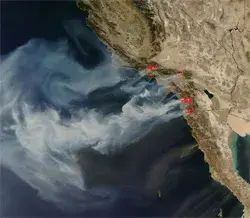 (October 2007) It didn’t take long for the recent wildfires in Southern California to spread from a local problem to a state and national crisis. President Bush issued an emergency declaration for seven counties, while the Red Cross, the National Guard, and the departments of Defense, Homeland Security, and the Interior were called to the scene. There was no role for the Department of Homeland Security (DHS) Science and Technology (S&T) Directorate, right? Research and innovation for tomorrow can’t possibly put out the fires of today, right?
(October 2007) It didn’t take long for the recent wildfires in Southern California to spread from a local problem to a state and national crisis. President Bush issued an emergency declaration for seven counties, while the Red Cross, the National Guard, and the departments of Defense, Homeland Security, and the Interior were called to the scene. There was no role for the Department of Homeland Security (DHS) Science and Technology (S&T) Directorate, right? Research and innovation for tomorrow can’t possibly put out the fires of today, right?
Perhaps. But fresh ideas and new ways of thinking can help to save lives and minimize damages down the road, if this kind of emergency ever happens again. The S&T Directorate is therefore canvassing the Federal research community, especially the DHS and National Laboratories, in search of potential solutions.
In an October 23 letter, Jay Cohen, DHS Under Secretary for S&T, asked the directors of several major labs to search for any technologies or capabilities that could aid firefighters and minimize the dangerous effects of wildfires. “[We] would like to expedite the utilization of applicable off-the-shelf technologies,” said Cohen, who proposed a “rapid response task force” on the issue. He said that expertise at the labs, combined with coordinated research programs and projects, could lead to technologies for preventing wildfires, protecting people and the environment from wildfires, suppressing and predicting the spread of wildfires, and supporting the first responders.
At Snapshots deadline (email press time?), scientists, engineers, and other researchers from the labs were preparing for a combined video teleconference with Directorate leaders. The plan: to bring lab minds and resources together to tackle the wildfire challenge, in a jiffy. The effort is now called Project SAFE (Secure Against Fires and Embers).
There’s already a precedent for this kind of collaboration. In August 2006, when a terrorist plot was uncovered in London to blow up transatlantic airliners using liquid explosives, the S&T Directorate called on the labs—literally. A similar conference call was held and a rapid response team was formed. This effort contributed to the quick adoption of the 3-1-1 Rule for liquids on planes and paved the way for some promising technologies for explosives screening.
Clearly, where there’s a will—and a team effort—there’s a way.
To request more information about this story, please e-mail st.snapshots@hq.dhs.gov
